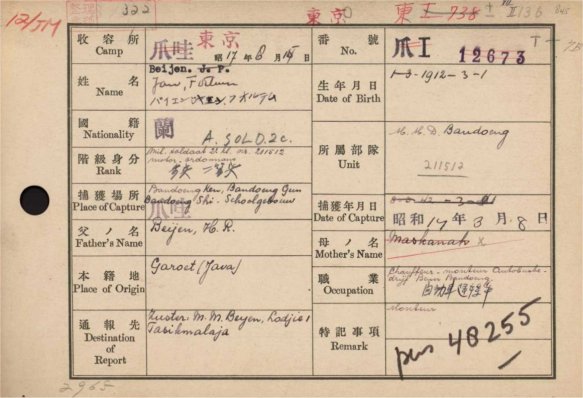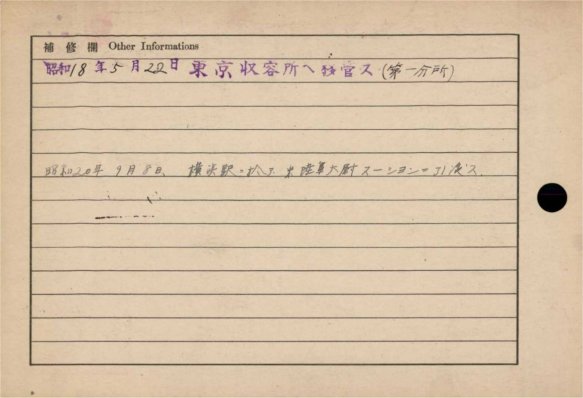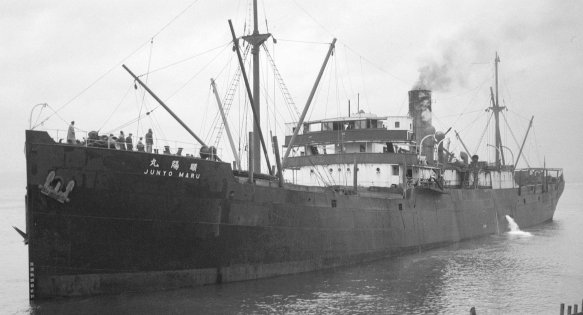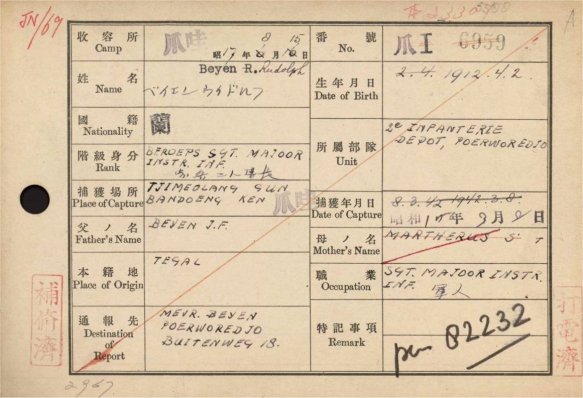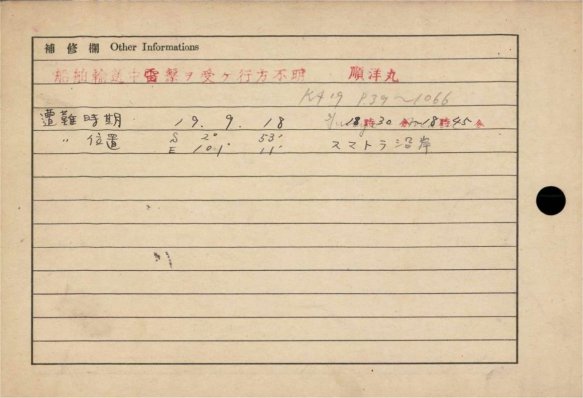|
|
|
|
The Johan Franco branch of the IJsselstein family
Victims of the Japanese occupation |
|
During World War II, numerous inhabitants of the Dutch East Indies of European or Indo-European descent were captured by the Japanese occupiers. This page is about five of them: the cousins Hendrik, Jan Fortuin, Rudolph and Christiaan Beijen/Beyen and Piet, the son of Hendrik. Because they were in service with the Royal Netherlands East Indies Army (KNIL) they were considered prisoners of war by the Japanese. Life in the camps was extremely hard.
Their Japanese internment cards are present at the National Archives. These cards are shown on this page, together with other information about what they experienced during the war.
Hendrik Beijen (1895-1945)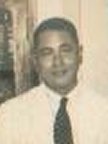 Hendrik Beijen (13.1), the son of Piet Beijen who is mentioned on the page Beijens in the Dutch East Indies, was born in 1895. At first he worked as a ship's engineer at the Navy and later he was a sergeant of the KNIL. Hendrik Beijen (13.1), the son of Piet Beijen who is mentioned on the page Beijens in the Dutch East Indies, was born in 1895. At first he worked as a ship's engineer at the Navy and later he was a sergeant of the KNIL.
After the Japanse invasion he was captured in prisoners' camps in Java. Later we was transferred to Sumatra, where he was forced to work at the notorious Pakanbaru railway. He died in September 1945, some weeks after the Japanese capitulation, because of the hardships he had endured. Below copies of the front and back of his internment card are shown. They can be enlarged by clicking on the images.
It appears from the Japanese text on the back of the card that he was captured on March 8, 1942. At first he was in a camp near Bandung in Java and later on in a camp near Batavia. In 1944 he was transferred to the large forced labor camp near Pakanbaru. He became ill on July 5, 1945 and died on September 10, 1945 as a result of beriberi. In the autumn of 1945 his remains were transferred to the Allies. Hendrik was buried on the war cemetery Kalibanteng near Semarang on Central Java. His monument is shown on the Dutch page Grafstenen en andere gedenktekens (Tombstones and other monuments). Piet Beijen/Beyen (1923-1997)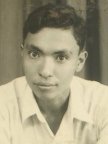 Piet Beijen (or Beyen) (14.1) was a son of Hendrik. He was born in 1923 in Surabaya. Piet Beijen (or Beyen) (14.1) was a son of Hendrik. He was born in 1923 in Surabaya.
The text on the front of the card shows that he served as a soldier in the infantry and was later interned as a prisoner of war by the Japanese. As a contact person, his mother G.H.S. Beyen Paulus in Semarang was mentioned, just like on his father's card above. A translation of the Japanese text on the front shows that he was captured on March 5, 1942, and interned in a camp in Thailand. 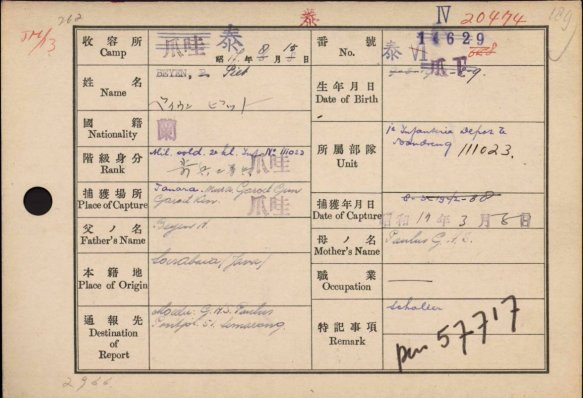
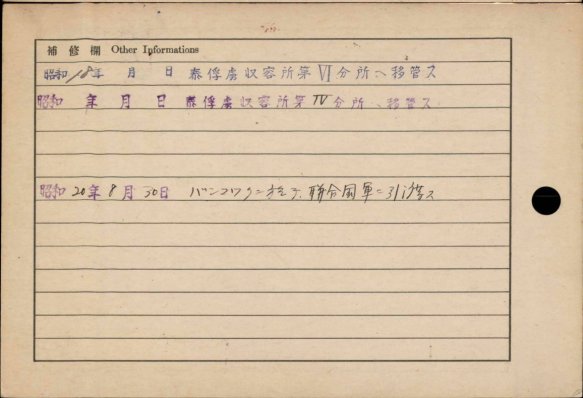
According to the Japanese text on the back of the card, he was transferred in 1943 first to the sixth and later to the fourth section of the POW camp in Thailand. It also states that he was handed over to the Allied Forces on August 30, 1945 in Bangkok. Piet married Elizabeth Mangundap in 1949 in Semarang, with whom he had one son. He worked at the NV Semarangsch Stoomboot- en Prauwenveer. Piet did apply for a Dutch passport after 1949, but remained in Indonesia. Elizabeth died in 1952, Piet died in 1997 in Cirebon on West Java. Jan Fortuin Beijen/Beyen (1912-1991)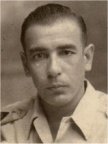 Jan Fortuin Beyen (or Beijen) (13.3) was the only son of Hendrik Rudolph Beijen Junior who was mentioned on the previous page. He was born in 1912 in Garut in Western Java as a son of the native woman Maskanah. Later he was acknowledged by Hendrik Rudolph as his son. According to what was told in the family Jan meant a fortune for his father. This should have been the background of his second given name. Jan Fortuin Beyen (or Beijen) (13.3) was the only son of Hendrik Rudolph Beijen Junior who was mentioned on the previous page. He was born in 1912 in Garut in Western Java as a son of the native woman Maskanah. Later he was acknowledged by Hendrik Rudolph as his son. According to what was told in the family Jan meant a fortune for his father. This should have been the background of his second given name.
Jan Beijen joined the KNIL. In the Second World War Jan Beyen was captured by the Japanese and transferred to the prisoners' camp Kawasaki near Tokyo. The prisoners of war in this camp had to do there forced labor in a shipyard for the Japanese war industry. 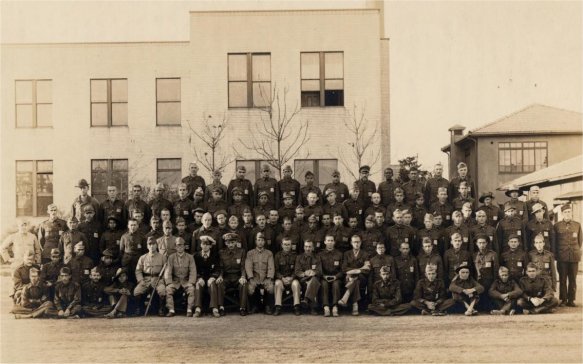
The front of the card shows that Jan Fortuin was a soldier 2nd class and served as a motor orderly, and that he also has been involved as a driver and mechanic in a bus company in Bandung.
Rudolph Beijen/Beyen (1912-1944)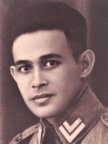 Rudolph Beijen (of Beyen) (13.8) was one of the sons of Johan Franco Beijen (12.6), who was in turn the youngest son of Hendrik Rudolph Senior (11.9). Rudolph joined the KNIL in 1929 and rose to the rank of sergeant major instructor. After the occupation of the Dutch East Indies by the Japanese, he was taken prisoner of war in March 1942. Rudolph Beijen (of Beyen) (13.8) was one of the sons of Johan Franco Beijen (12.6), who was in turn the youngest son of Hendrik Rudolph Senior (11.9). Rudolph joined the KNIL in 1929 and rose to the rank of sergeant major instructor. After the occupation of the Dutch East Indies by the Japanese, he was taken prisoner of war in March 1942.
In September 1944 he was one of the 6500 prisoners (American, Australian, British and Dutch prisoners of war and Javanese laborers) who were transported under inhumane conditions in the transport ship Junyo Maru to do forced labour at the Pekanbaru railway through the jungle of Sumatra.
However, the ship (above on a photo from 1933) was torpedoed and sunk west of Sumatra by a British submarine. Only a small part of the prisoners could save themselves. Rudolph Beijen was one of the thousands who perished.
Below the internment card of Rudolph is shown.
According to the Japanese text on the back of the card Rudolph was captured on March 8, 1942. Just like Hendrik he was at first in a camp near Bandung in Java and later on in a camp near Batavia. The exact time and place of the sinking of the Junyo Maru are stated: September 18, 1944, about 18:30 - 18:45 uur; 2º 53' South, 101º 11' East. After the war the widow and the three children of Rudolph Beijen moved to the Netherlands. Christiaan Beyen (1914-1997)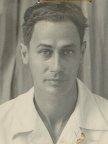 Christiaan Beyen (13.9) (commonly called Chris) was a brother of the aforementioned Rudolph. He was born in 1914 in Tegal. Christiaan Beyen (13.9) (commonly called Chris) was a brother of the aforementioned Rudolph. He was born in 1914 in Tegal.
Like his father Johan Franco, Chris went to work as a supervisor at the 'Boswezen', an organisation that was involved in forestry. In January 1942, Chris married Jenny Boogaard in Surabaya. In the meantime, the war with Japan had broken out. He was called up by the Dutch East Indies army and was placed with the motorcycle orderlies in Bandung. The army marched through the whole of Java, but soon surrendered. Chris then went to his grandmother in Tegal. In June 1942, Chris' and Jenny's first child, Victor, was born. In January 1945, the Japanese finally arrested Chris. He was taken to Padang on Sumatra to work on the Pekanbaru railway. 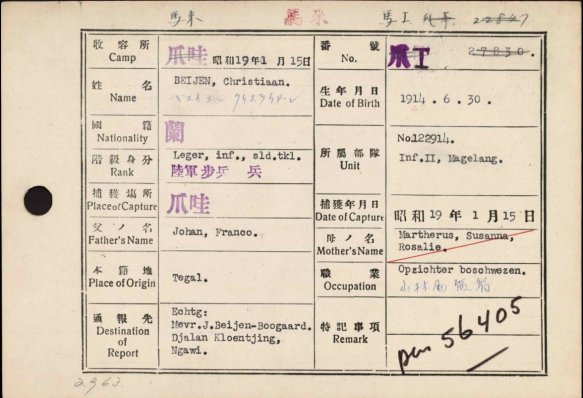
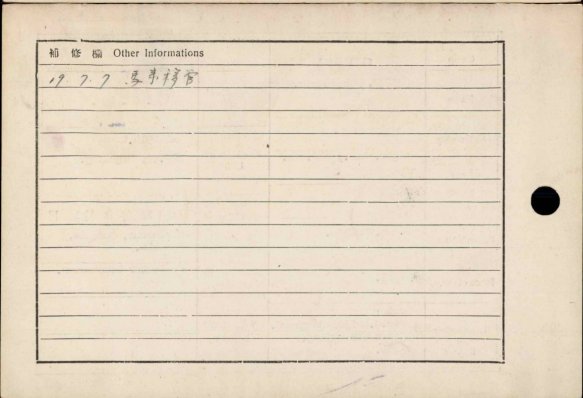
After the Japanese surrender in August 1945, Chris was able to return to Java. He was called up again by the army and was placed with the motorcycle orderlies in Batavia. His wife and son had been detained by the Japanese in the women's camp Tjideng near Batavia. After Chris had picked them up, he went with them first to Surabaya and later to Borneo. There he worked again for the Boswezen. Because of anti-Dutch measures in Indonesia, Chris left for Dutch New Guinea with his family around 1952. When that area was transferred to Indonesia in 1962, he went to the Netherlands with his wife and by then four children. Chris Beyen and his wife both passed away in Rotterdam in 1997. |
|
The next page The homepage |
The overview of the site The top of the page |
Searching this website Comments or questions |
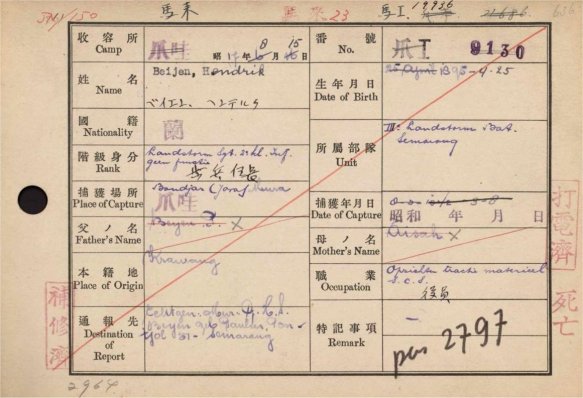
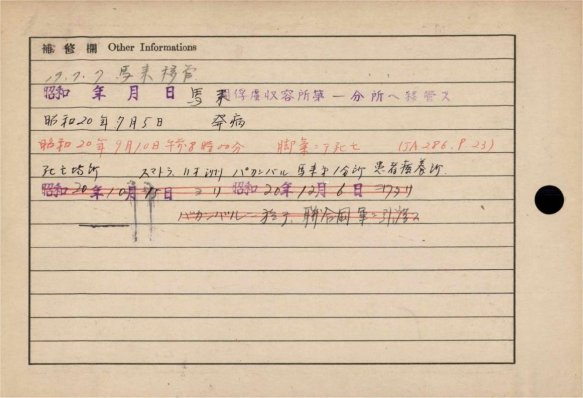
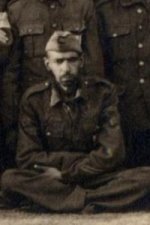 The picture above (Copyright by Al R. Young. All Rights Reserved. Courtesy of Al Young Studios.
The picture above (Copyright by Al R. Young. All Rights Reserved. Courtesy of Al Young Studios. 